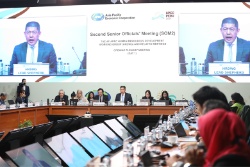Stories From Islands In The Clouds – The Savaii BIORAP
Stories From Islands In The Clouds – The
Savaii BIORAP
The Secretariat of the Pacific Regional Environment Programme (SPREP) and the Samoa Ministry of Natural Resources and Environment (MNRE) have recently completed a 12-day intensive survey of the wildlife in the highest point of Samoa – the Savaii upland cloud forest.
The Rapid Biodiversity Survey (BIORAP) covered around 100 square kilometres of extremely rugged and inaccessible terrain to a height of 1,870metres (6,100 feet) above sea level.
“We are all now much more aware why there is a dearth of information on the fauna, and to some degree the flora, of this very remote and little visited area,” said Bruce Jefferies, SPREP’s Terrestrial Ecosystems Management Officer.
Mr Jefferies explained that getting equipment, food and water to the top of the cloud forest was a major undertaking and, coupled with uncertain weather conditions, makes carrying out such a survey generally impossible.
“In fact, without the significant support provided by the New Zealand Defence Force helicopter squadron, covering this area would have been an impossible objective.”
The survey was timed to coincide with the New Zealand Defence Force presence in Samoa during the nation’s 50th Independence anniversary celebrations.
“Unfortunately, this meant that we were also at the mercy of the uncertain May weather,” said Mr Jefferies.
The survey strategy involved dropping teams of experts at various pre-indentified helicopter landing zones for 1–2 nights and then to relocate them to other sites. Unfortunately, the poor weather conditions meant that at one stage 3 teams totalling 12 people were stranded in very wet conditions. The low cloud and rain also meant that helicopter evacuations were impossible and for a couple of days all that could be done was to wait for a weather clearance.
“To give an idea of the amount of rain that fell before the evacuation when the teams landed in the crater where they set-up their camp the floor of the cater was completely dry – after 24 hrs of rain about 2.5m of water had accumulated and was forcing the research teams progressively up the side of the crater wall. At one camp, people were swimming across the crater to retrieve survey monitoring equipment!”
Despite these set-backs, the teams of experts on birds, insects, reptiles and plants are confident that they have enough information to make an initial analysis of the biodiversity of the cloud forest.
However, information will not be available for some months as the scientists now need to undertake the time consuming process of examining their findings and collections in detail in order to verify new species.
The survey did produce some sobering news in terms of some of the bird species that are of particular significance because of their national and global status.
Dr David Butler, who coordinated the bird teams, commented that: “In brief, the teams made only one uncorroborated sighting of a manumea during the survey and heard only one or two sequences of calls that could be attributed to this species but which we thought equally likely to be being made by the Pacific pigeon or lupe.”
He added that the team did sight good numbers of lupe and the white-throated pigeon or fiaui.
“While the survey was not specifically designed for the manumea alone and the timing may not have been the perfect time of year to detect this bird, we saw enough to conclude that upland Savaii is not the stronghold for this species that we had hoped,” said Dr Butler.
The bird team were also not able to find the Samoan woodhen, or punae, leading to serious concerns that it may indeed be extinct, as earlier feared.
The insect team collected a significant number of specimens and it is confidently expected that a percentage of these will be new discoveries for both Samoa and science generally. The snail expert also thought that several of the specimens collected would be new species.
A small team focused on reptiles – skinks and lizards – and as part of their work, an altitudinal transect from sea level to 1700m, was completed. This work, when the findings have been fully analysed, will provide new data on the distribution of skinks and lizards in Samoa.
Under the very experienced direction of Dr Art Whistler, the botanical team undertook a number of vegetation transects within different forest types and elevations. Of all the scientific specialities, the botany of the Savaii uplands is arguably the best known and documented. In spite of this, new plant species are expected to be announced when findings from the BIORAP are collated.
The BIORAP Survey was funded by the Critical Ecosystems Partnership Fund (CEPF) and was undertaken by the Secretariat for of the Pacific Regional Environment Programme in partnership with the Ministry of Natural Resources and Environment (MNRE) and local communities on Savaii.
ENDS


 Being LBGTI in Asia: UNDP And ILGA World Launch The International Pride Awards, Recognising LGBTIQ+ Equality Champions
Being LBGTI in Asia: UNDP And ILGA World Launch The International Pride Awards, Recognising LGBTIQ+ Equality Champions UN News: UN Teams Dispatch Aid As Deadly Flash Floods Hit Northern Afghanistan
UN News: UN Teams Dispatch Aid As Deadly Flash Floods Hit Northern Afghanistan Save The Children: It’s Not Safe And It’s Not Clean, But People Believe They Are Leaving Something Worse Behind
Save The Children: It’s Not Safe And It’s Not Clean, But People Believe They Are Leaving Something Worse Behind APEC: APEC Commits To Empowering People With Disabilities
APEC: APEC Commits To Empowering People With Disabilities UN News: Israeli Forces Bringing War To The West Bank, Warns UN Rights Office
UN News: Israeli Forces Bringing War To The West Bank, Warns UN Rights Office UN News: 10,000 People Feared Buried Under The Rubble In Gaza
UN News: 10,000 People Feared Buried Under The Rubble In Gaza